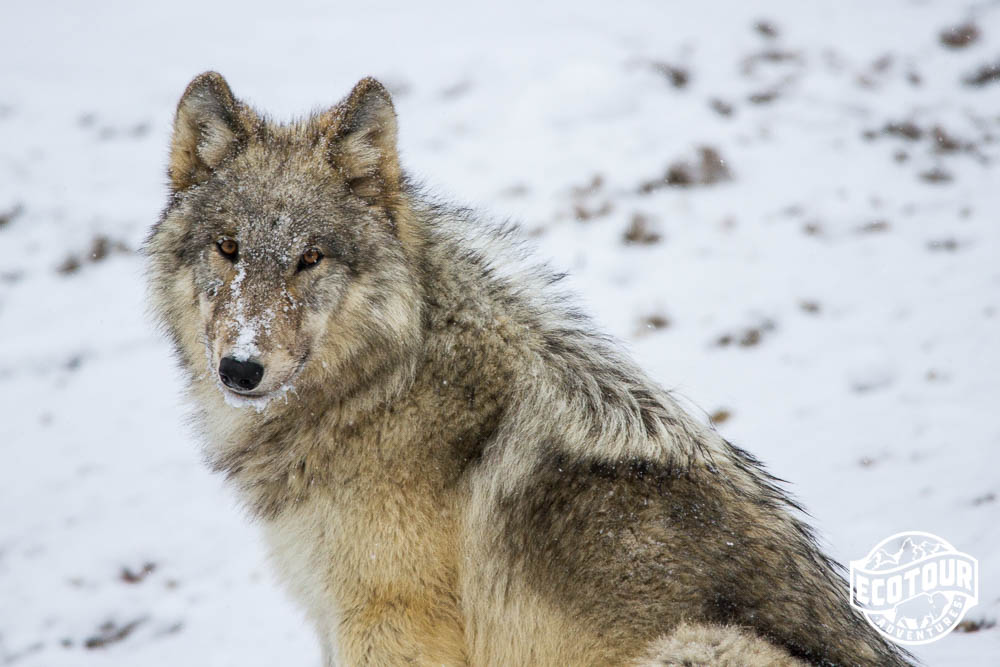Trip Report: Winter in Wonderland Grand Teton and Yellowstone Adventure
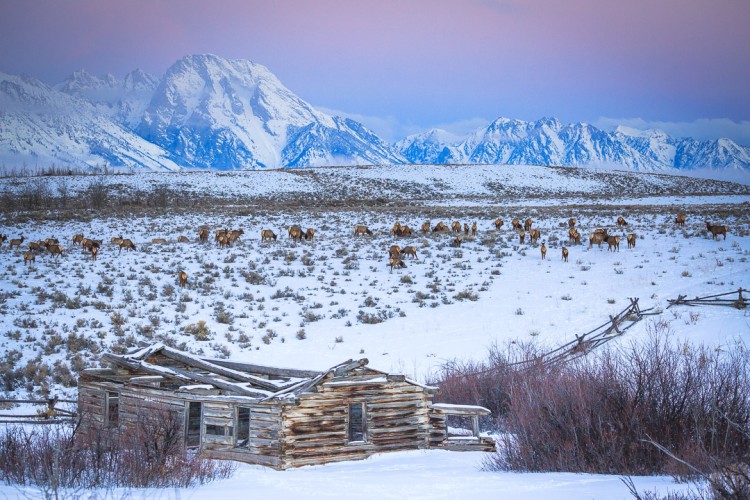

Alpenglow lights up the Jackson Hole Valley as a herd of elk passes by the historic Shane Cabins in Grand Teton National Park.
As snow blankets the mountains and valleys of Grand Teton and Yellowstone National Parks, a peaceful quiet falls across the landscape. The crowds of summer are gone from this winter wonderland, yet opportunities abound for wildlife and national park enthusiasts to take it all in.
Each winter, the guides at EcoTour Adventures lead our guests on week-long expeditions across the Greater Yellowstone Ecosystem, starting beneath the Mighty Teton Range in Jackson Hole, continuing into the snowy geyser filled interior of Yellowstone, and culminating with wildlife watching along Yellowstone’s Northern Range. Read on for a Trip Report from one such adventure through winter in wonderland.
The Winter Wildlife and Mountains of Grand Teton
Following an orientation dinner and night in the town of Jackson, WY, I pick up our guests for a sunrise wildlife tour of Grand Teton National Park and the National Elk Refuge. Alpenglow turns the snowy peaks pink as we drive along the Gros Ventre River in search of moose. It’s early winter and the tops of sagebrush are still visible in Antelope Flats where we find not one but a dozen bulls concentrated in the open fields. Moose are usually solitary animals, but gather this time of year to browse on bitterbrush, a woody shrub that grows alongside the larger sagebrush. Many of the bulls were still carrying antlers, which are shed later in January.
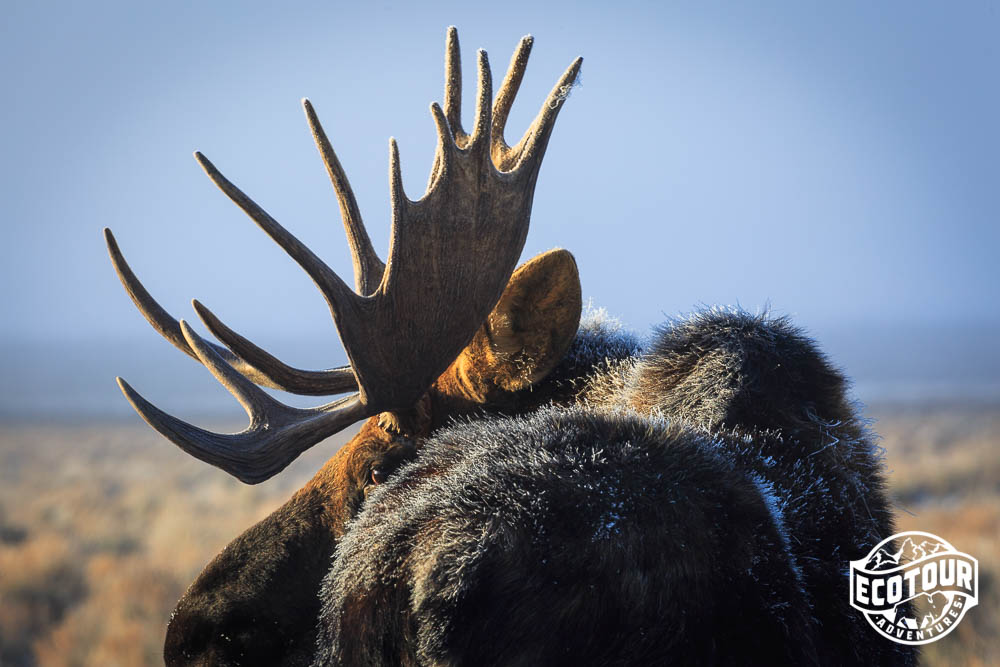
Moose are the largest member of the deer family and can weigh upwards of 1000 lbs!
In early winter, elk are still migrating to winter range and we locate a sizable herd near the Shane Cabins. The herd, led by an experienced matriarch, often follow the same migration routes each year. They’ve retreated from their now snow-covered summer range into the lower elevation Jackson Hole Valley and will soon end up on the nearby National Elk Refuge.
Diverse wildlife find a home on the National Elk Refuge
At the northern end of the National Elk Refuge we stop to glass the open waters of a spring-fed pond. Each winter over 1000 trumpeter swans return to the Greater Yellowstone Ecosystem from summer nesting areas, taking advantage of open water like this one to forage from. This formerly rare species is joined by numerous waterfowl species, whether mallards, gadwall, pintail, goldeneye, or buffleheads.
We pass by massive herds of elk as we head to the southern edge of the refuge. Here, amongst the windswept cliffs of Miller Bute, we find bighorn sheep. Bighorn return to these cliffs each year after summering 4000’ feet up in the high country of the nearby Gros Ventre Mountains. The cliffs provide valuable refuge habitat which allows the sheep to quite literally take the higher ground should a predator approach. I’ve watched on several occasions as a herd of ewes and lambs shelter from a coyote or wolf, skillfully navigating the steep cliffs. These cliffs are also great locations to look for golden eagles, who, in addition to scavenging carcasses, have been known to attempt to push lambs off of cliffs!
A Sleigh Ride Through the Jackson Hole Elk Herd
For over 100 years horse-drawn sleighs have driven through the Jackson Hole Elk herd in winter, first to provide hay for the wintering ungulates, and now to allow close up views of these charismatic animals. The elk have grown accustomed to this odd sight and largely ignore the giant draft horses and visitors taking in the view. In addition to hundreds of elk, we also spot bald eagles in a nearby cottonwood tree, coyotes in the distance, and waterfowl in the winding meanders of Flat Creek.
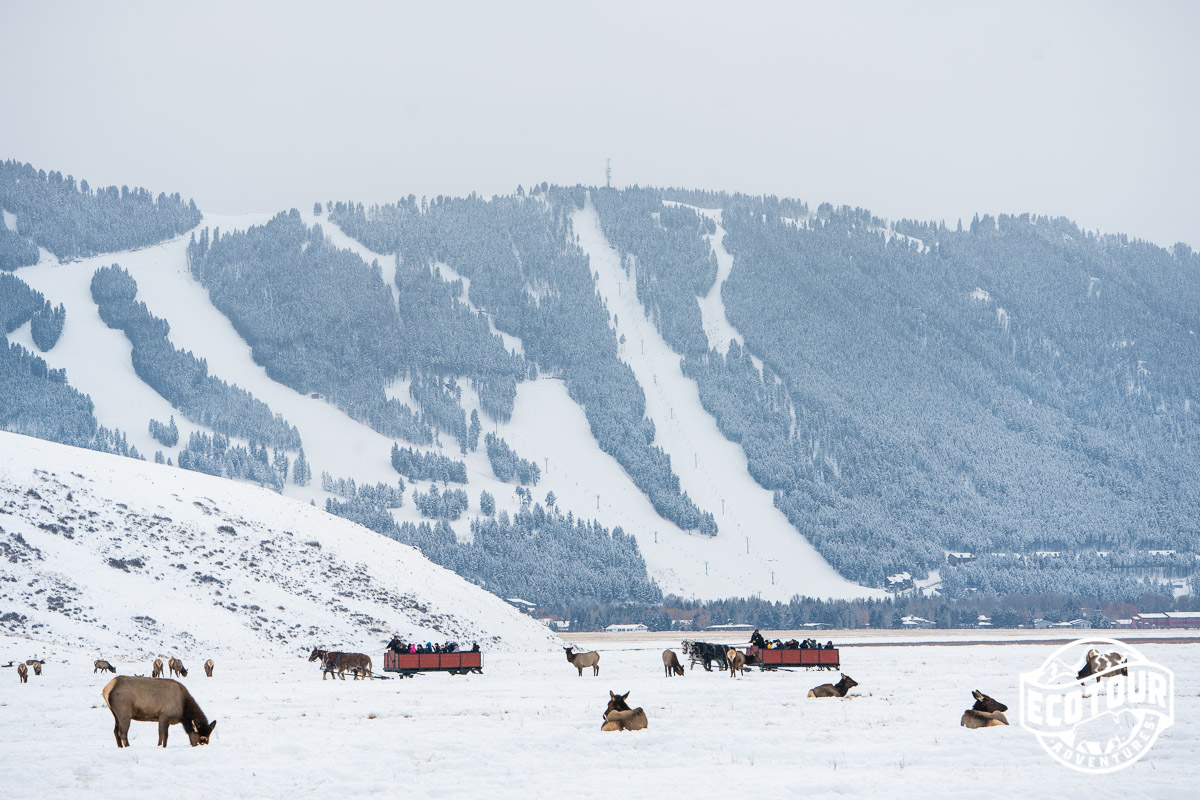
Watching elk via horse-drawn sleigh on National Elk Refuge in Jackson Hole.
Wolves can also be found in Grand Teton and on the National Elk Refuge but on this day we were unsuccessful in viewing these wary carnivores. We didn’t know it yet, but our wolf watching luck would change dramatically a few days later in the snowy interior of Yellowstone National Park.
Winter Wonderland - Yellowstone’s Snowy Interior
After a full day and morning exploring the Jackson Hole Valley we head north through Grand Teton National Park to Flagg Ranch and the South Entrance of Yellowstone National Park. We board a snowcoach, specially designed vehicles that travel over the snow-packed roads of the lower loop of Yellowstone. In winter, the high elevation Yellowstone Plateau closes to wheeled vehicles, and most hotels and other amenities close down. The formerly busy park empties of visitors save the few who venture inward for day trips or to stay at the Old Faithful Snow Lodge.
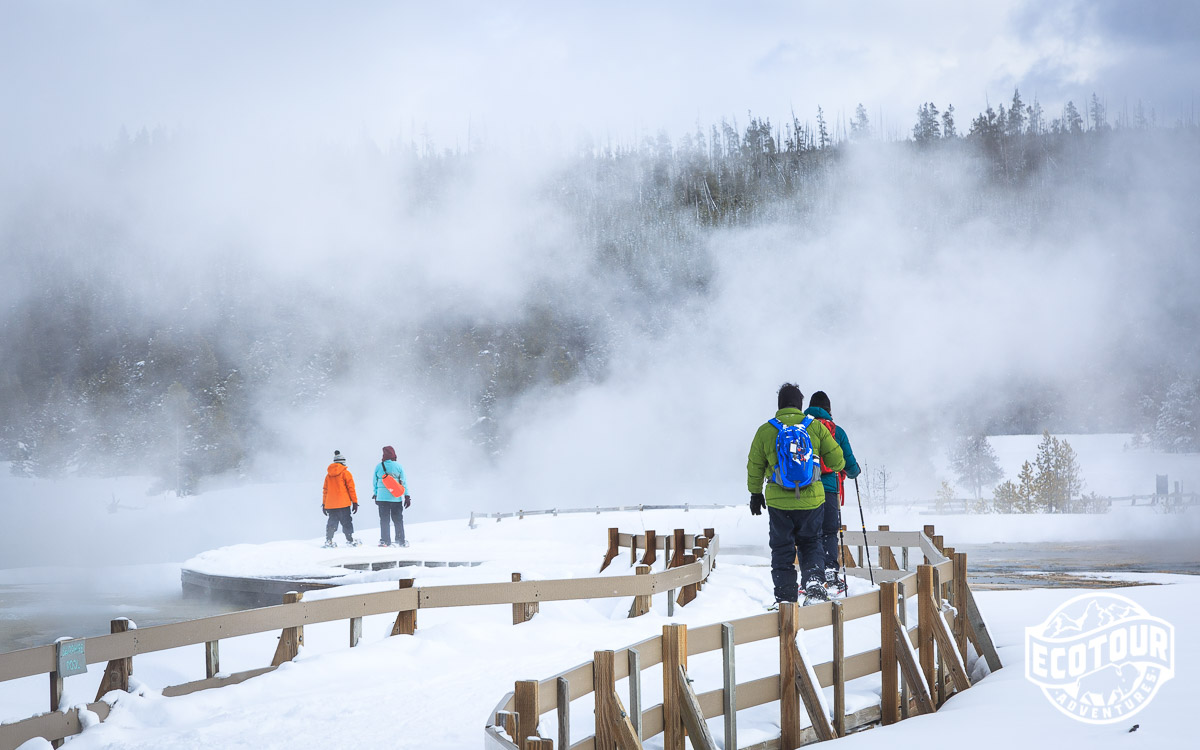
In winter it’s not uncommon to have Yellowstone’s thermal basins all to yourself!
Our snowcoach takes us into the interior of Yellowstone towards Old Faithful and the Snowlodge. Along the way, we stop to take in the steaming West Thumb Geyser Basin and ice-covered Yellowstone Lake. Yellowstone National Park is home to over 10,000 thermal features, over half of those found in the world, holes in the thick ice indicate that some of them occur beneath the lake’s surface.
We travel on to the Old Faithful Snowlodge, our lodging for the next two nights. In summer, the Old Faithful area is among the busiest locations in the park. Though day tours still reach the famous geyser in winter, the area is peacefully quiet in the morning and evening hours, ours to explore free from crowds.
The area has numerous snowshoeing or XC Ski trails, or for those who prefer walking, heat from nearby thermal features often melts the snow on boardwalks meandering through diverse thermal features. We opted to use EcoTour ski poles and grippy YakTrax to enjoy the sights and sounds of the Upper Geyser Basin.
Wolves and Waterfalls in Yellowstone’s Lower Loop
On our second day exploring the interior of Yellowstone we board a snowcoach to explore other areas of the Lower Loop. In winter, deep snow forces many animals to migrate out of the park’s interior but areas such as the Madison River offer winter habitat. We head down the river corridor watching as bison and the occasional coyote walk by along the snow-covered road.
Nearing the 7 Mile bridge we see a large gathering of several dozen ravens and magpies in the meadow. It’s a fresh bison carcass, and the ravens scatter as a bald eagle flies in. We watch, laughing as the ravens take turns pulling the eagles tail feathers to distract it while another lunges in to grab pieces of meat. A coyote, looking over its shoulder, slinks in to join the feast. Suddenly, the coyote bolts, and we look over as a gray wolf approaches! It’s a member of the Wapiti Lake Pack, one of the only packs using the interior of the park. The rest of the pack is likely resting out of sight with full bellies and we watch in awe as the apex carnivore attempts to chase away ravens in between bites.
It’s been 25 years since successful wolf reintroduction in Yellowstone, and winter is one of the best times of year to view this iconic symbol of wildness.
Satisfied with our view of the wolf, birds, and coyote, we head off towards the Grand Canyon of the Yellowstone. Alone at Lookout Point, we hear the roar of the 308’ Lower Falls of the Yellowstone River and take in the stunning canyon. The mist from the falls freezes into a massive ice bridge each year, obscuring the terminus of the falls from view.
We head into the Hayden Valley searching for otters along the Yellowstone River, taking in the frozen, minimalist landscape now slumbering beneath a blanket of snow. Our day concludes back at the Snow Lodge, warmed by the fire and a mug of hot apple cider.
The American Serengeti, Yellowstone’s Northern Range
My favorite area of Yellowstone is the wildlife-rich Northern Range. This lower elevation area of the park and the nearby Paradise Valley contains winter habitat for all 8 of our hoofed mammal species, bison, bighorn sheep, mountain goats, pronghorn antelope, mule and white-tailed deer, elk, and moose. The rugged Absaroka-Beartooth Wilderness surrounds the northern border of the park, this truly wild country made Yellowstone an easy choice for wolf reintroduction in 1995. At least four different wolf packs actively use this territory, and the chances of seeing them in winter are so good we run wolf and wildlife specific tours of the Northern Range each winter!
In the Lamar Valley, we listen to American dippers sing along the river, while watching bighorn rams graze on the hill above us. A bull bison sweeps his head through deep snow, plowing down to the grasses hidden below. The aptly named Thunderer Mountain towers over the valley, and we use spotting scopes to spy on mountain goats clinging to the cliff walls.
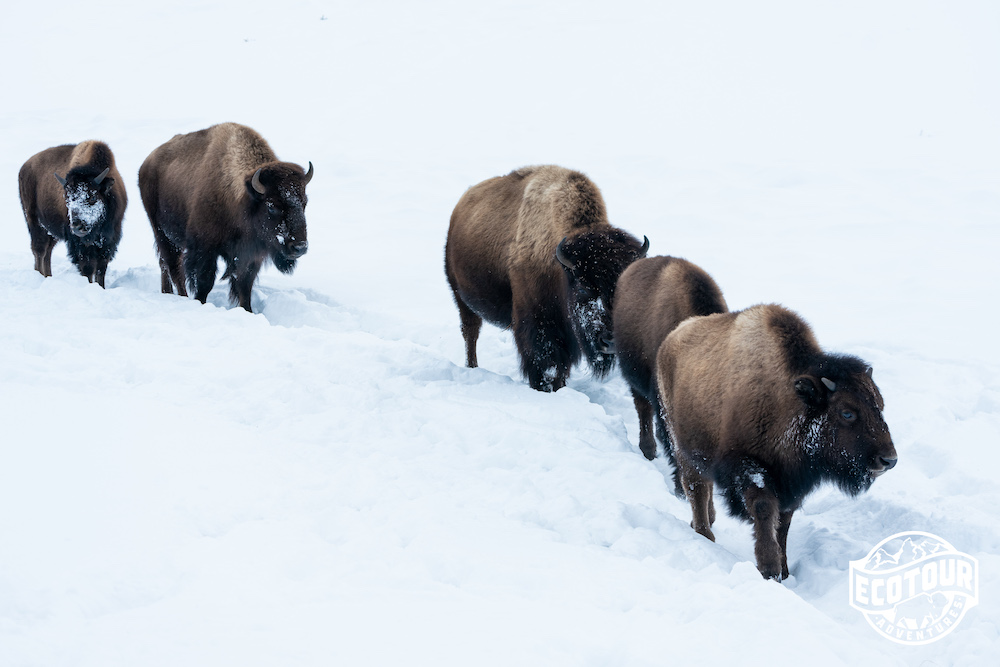
The upper vertebrae of bison can be well over a foot long, this “vertical process” as it is called, provides structural support for the muscles which allow bison to use their heads as snowplows.
We encounter the Junction Butte wolf pack traveling through the snow, watching through our spotting scopes. Wolves are naturally wary of people, but the massive open vistas of the Lamar provide ample opportunities to observe them from a distance.
Though I’ll always enjoy sharing wolf sightings with guests, my favorite sighting of this trip was a small but mighty predator, the long-tailed weasel. These speedy predators are so lean they must eat every day to survive the cold, so sightings are almost always fleeting. It’s blurry white shape catches my eye and we pull over to watch. The weasel stops, and stands vertical, eyeing us as if to say “if you were a little smaller you’d be my lunch!” He’s not wrong, weasels have been known to hunt and kill animals 10 times their size!
On our final day, we take in one more thermal feature, the stunning Mammoth Terraces, before departing Yellowstone National Park. The adventure is far from over, however. Near the park boundary, we find a giant bighorn sheep ram, I estimate to be 11 years old by counting the annuli, or growth rings, on his horns. We spot hundreds of pronghorn antelope, mule and white-tailed deer in the Paradise Valley as we drive towards our final destination of Bozeman. Rough-legged hawks, bald and golden eagles perch along the Yellowstone River as it winds its way northward.
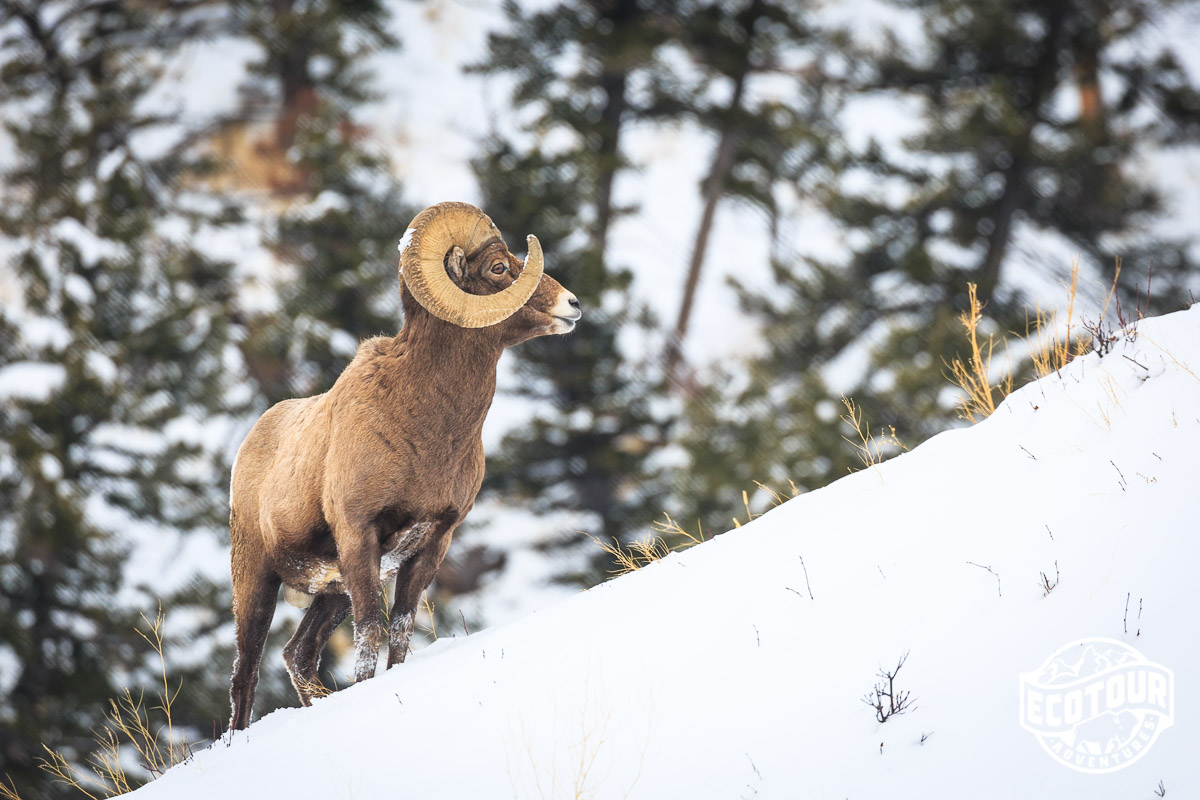
Annuli are darker bands on a bighorn sheep horn which represent slower growth during the winter months, how many can you count in this photo?
Spending our final days of the tour taking in the wildlife of the Northern Range of Yellowstone is a fitting way to conclude our winter Adventure. Yellowstone was founded to preserve the stunning thermal features and landscapes we’d taken in, yet today most recognize it’s intact ecosystem and the presence of all of the large mammals which were found here pre Lewis and Clark to be its greatest value. There are few places left on earth like Yellowstone and Grand Teton National Parks, and we’re thrilled to share their splendor with our guests each year.
To join us on this years’ Winter in Wonderland Grand Teton and Yellowstone Adventure visit the tour page, or contact us directly 307-690-9533 info@jhecotouradventures.com Private tours and dates are also available!
2021-2022 8 day Winter in Wonderland Adventure Dates
January 8th - 15th 2022 Call 307-690-9533 to Book!
Josh Metten is a Senior Naturalist and Photographer for EcoTour Adventures.


